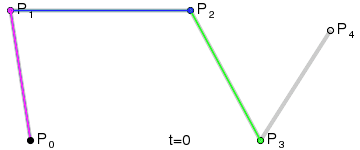This post contains the answers to this week's Sunday Afternoon Maths and some extension problems based around the originals.
Three Squares
Draw three more squares and add these lines (I have coloured the angles to make equal angles clearer):
Triangles \(ACE\), \(LDK\) and \(IKE\) are congruent, so angle \(KDL\) is equal to \(\beta\).
The congruence of these triangles tells us that angles \(DKL\) and \(EKI\) add up to a right angle, so angle \(EKD\) is also a right angle.
The congruence of the triangles also tells us that \(KD\) and \(KE\) are the same length and so angle \(EDK\) is the angle in an isosceles right-angled triangle. \(\alpha\) is also the angle in an isosceles right-angled triangle, so these two angles are equal.
Therefore \(\alpha+\beta+\gamma=90^\circ\).
Extension
The diagram shows three squares with diagonals drawn on and three angles labelled.
What is the value of \(\alpha+\beta+\gamma\)?
Equal Opportunity
Let \(p_1\), \(p_2\), ..., \(p_6\) be the probabilities of getting 1 to 6 on one die and \(q_1\), ..., \(q_6\) on the other. The probability of getting a total of 2 is \(p_1q_1\) and the probabilty of getting a total of 12 is \(p_6q_6\). Therefore \(p_1q_1=p_6q_6\).
If \(p_1\geq p_6\) then \(q_1\leq q_6\) (and vice-versa) as otherwise the above equality could not hole. Therefore:
$$(p_1-p_6)(q_1-q_6)\leq 0$$
$$p_1q_1-p_6q_1-p_1q_6+p_6q_6\leq 0$$
$$p_1q_1+q_6p_6\leq p_1q_6+p_6q_1$$
The probability of rolling a total of 7 is \(p_1q_6+p_2q_5+...+p_6q_1\). This is larger than \(p_1q_6+p_6q_1\), which is larger than (or equal to) \(p_1q_1+q_6p_6\), which is larger than \(p_1q_1\).
Therefore the probability of rolling a 7 is larger than the probability of rolling a two, so it is not possible.
Extension
Can two \(n\)-sided dice be weighted so that the probability of each of the numbers 2, 3, …, 2\(n\) is the same?
Can a \(n\)-sided die and a \(m\)-sided die be weighted so that the probability of each of the numbers 2, 3, …, \(n+m\) is the same?
Double Derivative
(i) \(\frac{dy}{dx}=1\), so \(\frac{d}{dy}\left(\frac{dy}{dx}\right)=0\)
(ii) Differentiating \(y=x^2\) with respect to \(x\) \(\frac{dy}{dx}=2x\). Let \(g=\frac{dy}{dx}\). By the chain rule:
$$\frac{dg}{dy}=\frac{dg}{dx}\frac{dx}{dy}$$
$$=2\frac{1}{2x}$$
$$=\frac{1}{x}$$
So \(\frac{d}{dy}\left(\frac{dy}{dx}\right)=\frac{1}{x}\)
(iii) By the same method, \(\frac{d}{dy}\left(\frac{dy}{dx}\right)=\frac{2}{x}\)
(iv) \(\frac{d}{dy}\left(\frac{dy}{dx}\right)=\frac{n-1}{x}\)
(v) \(\frac{d}{dy}\left(\frac{dy}{dx}\right)=1\)
(vi) \(\frac{d}{dy}\left(\frac{dy}{dx}\right)=-\tan(x)\)
Extension
What is
$$\frac{d}{dy}\left(\frac{dy}{dx}\right)$$
when \(y=f(x)\)?





















